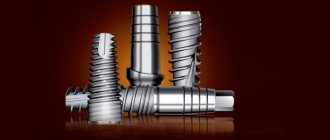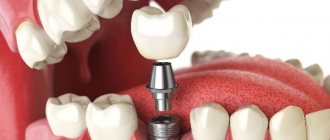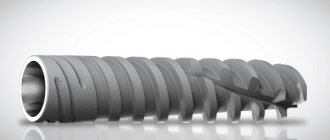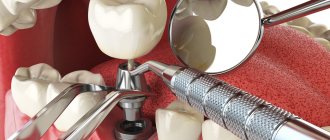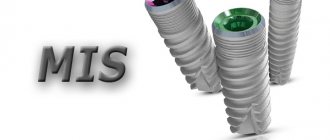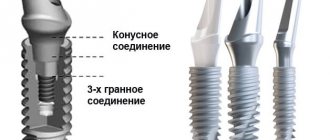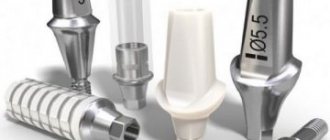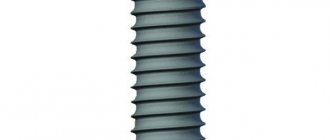1458
The effectiveness of the implantation procedure depends on many things - the professionalism of the dentist, the condition of the patient’s oral tissues, and compliance with the specific care of the system in the postoperative period.
But the most important factor is the quality of the artificial root, its technical characteristics and performance properties.
Among the variety of dental structures used in well-known dental centers, South Korean implants called Inno are very popular.
About the manufacturer
The South Korean company producing artificial roots Inno was founded in 1993.
The competitiveness of implants produced by CowellMedi Co., LTD is achieved by reducing their cost, thanks to the use of innovative technology.
This brought the company's products to a leading position in the middle price segment not only in the Asian market, but on the European continent.
In addition to implants, the company produces numerous instruments for dental operations and materials for transplantations. All of the manufacturer’s products undergo thorough testing , which is confirmed by international quality certificates.
System characteristics
The uniqueness of Inno implantation systems lies in the fact that during their development, specialists relied on the physiological and biological processes occurring in the human body.
This is reflected in the following characteristics of the dental system:
- Material. Artificial roots are made of pure titanium, which does not contain additional impurities.
This guarantees the elimination of the risk of developing an allergic reaction and rejection of the structure, due to its high biological compatibility with the tissues of the human oral cavity.Another feature of the material is its ability to withstand high loads without the risk of deformation, which allows the implantation of chewing teeth.
- Form. To ensure high primary stability and reliable osseointegration, the implant combines several structural features.
The conical shape in the root section helps reduce the invasiveness of the rod insertion. The cylindrical design of the remainder of the body ensures that the structure remains firmly in place. The reduced diameter of the cervical area allows you to quickly and safely insert the implant into the bone tissue. - Thread. The product combines two types of thread - Buttress and Spiral lock. The thread depth is 0.3-0.35 mm, the distance between the turns is 0.8 mm.
Thanks to these features, it is possible to use various implantation protocols - one-stage, classical, after bone grafting.Two types of thread guarantee reliable stabilization of the titanium rod, reduction of the duration of the implantation procedure, and rapid osseointegration.
- Coating. The implants have a rough, uniform surface, which is achieved by treating the product with calcium hydroxyapatite.
This ensures a high rate of regeneration of the bone into which the structure is embedded. Due to the high hydrophilicity of the rod, the process of its engraftment in bone tissue is accelerated. - Connection of the implant to the abutment. The product uses a conical type connection called a Morse cone.
It assumes the absence of gaps between the component parts of the artificial root, which prevents the penetration of microorganisms into its body and prevents the risk of inflammation of the bone tissue and rejection of the structure.The hex connection allows the use of abutments from other dental systems.
The combination of the listed structural features in Inno implants allows us to achieve a high degree of engraftment of the products, ensure strong fixation and reduce the risk of complications.
Review of the design of Camlog implants, their types and purpose.
Visit here to learn more about the Snucone implant system.
At this address https://zubovv.ru/implantatsiya/proizvoditeli/chem-privlekayut-frantsuzskie-tbr.html you will find all the most important things about TBR implants
Advantages and features of Inno implants.
In the production of INNO implants, much attention is paid to osseointegration, because there are cases when, after installation, necrosis (atrophy) of bone tissue occurs due to overheating and excessive pressure during the procedure.
Such consequences are practically eliminated by the special shape of the INNO implant, which is two-thirds cylindrical and one-third conical. This hybrid design in combination with two types of thread ensures optimal load distribution, proper functioning of the prosthesis installed on the implant, eliminates overstrain of the jaw bone and guarantees the most comfortable and rapid healing. INNO implants are made from titanium, a metal that does not cause allergic reactions and has excellent biological compatibility with bone mass. The best adhesion to the bone is ensured by the special rough SLA surface of the product, obtained as a result of etching with calcium hydroxyapatite. Thanks to this porous structure, the bone tissue literally grows into the implant, ensuring its maximum fixation.
In addition to implants, CowellMedi produces bone graft materials coated with recombinant protein (rhBMP-2), which can help patients with bone deficiency. Manufacturers have not forgotten about doctors, for whom they produce modern surgical instruments, as well as equipment (piezosurgical device PiezoART, centrifuge Scilogex DM0412).
INNO implants are used as a support for removable and stationary dentures in any clinical cases, even with complete edentia. The products are used both for classical implantation in two stages, and for express implantation. The use of INNO implants allows you to achieve maximum cosmetic effect.
Types of structures and purpose
To ensure the possibility of implanting Inno implants in various clinical situations, developers have released several types of design:
- Rods with implant driver. The products are fixed in the lateral parts of the jaw arch and areas that are difficult to access.
The diameter of the rods ranges from 3.5 to 6.0 mm. The length of titanium roots can be 8/10/12/14 mm. Rods with a diameter of 6.0 mm have the following length options - 7/8/10/12 mm. - Rods without implant driver. Titanium roots are used to restore teeth in the frontal area of the upper and lower jaw. Variations in length and diameter do not differ from the variety described above.
- Short rods. The implants have a diameter of 5/5.5/6 mm. Their length is 4 mm. The products are fixed in areas with a minimum amount of inert tissue.
The choice of a specific implant model is made by the attending physician based on an examination of the patient’s oral cavity, the condition and volume of his bone tissue.
Implantation techniques
- Implantation with delayed loading . The classic method involves implanting a titanium rod into the jawbone. Engraftment takes 3-5 months, then prosthetics are performed.
- Basal implantation with immediate (instant) load . Unlike implantation with delayed loading, implantation can be performed when there is insufficient bone tissue. For this, non-separable structures are used that involve all parts of the jaw bone and can be implanted at an angle without interacting with atrophied areas. Implants are loaded 2-7 days after installation. With the help of dentures, the structure is connected and stabilized, the nutrition of the jaw bone is activated, which helps to accelerate healing.
- Implantation after tooth extraction (express method). It is performed simultaneously - the titanium root is inserted into the hole formed after tooth extraction. Implantation can be carried out with either immediate or delayed loading, depending on the indications.
- Mini-implantation. Small, thin dental structures are used that serve as additional fixation for removable orthopedic systems.
- Combined implantation . Several methods are used simultaneously, taking into account the number of lost teeth, the state of the bone structure of the jaw, the requirements for functionality and aesthetics of structures.
Installation protocol
The implantation procedure is preceded by a thorough examination of the patient’s oral cavity. At this stage, the specialist determines whether there are contraindications to the operation, whether there are dental diseases that require elimination before implantation of an artificial root.
Using computed tomography, the quantity and quality of bone tissue is determined, on the basis of which an implantation plan is drawn up.
When pathological processes are identified in the oral cavity, they are eliminated - treatment of caries, removal of hard deposits, therapy of inflammatory gum diseases.
The procedure for direct implantation consists of the following steps:
- Administration of local anesthetic or general anesthesia for simultaneous fixation of several artificial roots.
- Excision of the gums with drilling of the bone tissue to the required depth using special cutters. Formation of a bone bed for the implant.
- Inserting a rod into a drilled hole. Fixing the plug.
- Suturing of gum tissue.
The duration of the healing process of soft tissues and the fusion of the product with the bone depends on many factors - the health of the patient, the quality of the implant, and the method of its fixation.
After completion of the osseointegration process, which lasts from 2 months to six months, the specialist fixes the abutment. After another 2-3 weeks, after the formation of the gum contour, prosthetics are performed.
The implantation protocol may differ slightly depending on the condition of the patient’s tissues:
- If the volume of bone tissue is small, before implanting a titanium rod, a sinus lift procedure is performed by transplanting one’s own biological material or artificial tissue.
- With instant implantation, the root is implanted simultaneously with tooth extraction. Also during this appointment, the abutment and temporary crown are fixed.
The choice of implantation method is made by the attending physician. It depends on the initial state of the elements and tissues of the patient’s oral cavity.
At the end of the procedure, the specialist gives recommendations on caring for the oral cavity during the postoperative and recovery period. A date for the next visit is also set to assess the condition of the tissues and the progress of the osseointegration process of the implant.
Implants are not the only product produced
In addition to implants, U-impl produces the following products for prosthetics:
- Gum formers are used to give the desired relief to the gums after installation of an artificial root.
- Shaping rings, also used for gum shaping.
- Transfers, installation keys, implant and abutment analogues, which are used to create a plaster model of a number of teeth.
- Inter abutments for cemented prostheses.
- Screw-retained abutments used for removable and conditionally removable dentures when more than two teeth are missing.
- Screws for attaching the abutment to the implant.
- Implantation kits, including surgical and orthopedic instruments needed to implant an artificial root.
- Drills for choosing the direction of implant installation.
- Mills for forming a bone bed.
- Cement for fixing crowns.
Warranties and service life
Inno implants belong to the mid-priced dental products. Typically, the manufacturer's warranty for such products is 10-15 years.
This refers to the integrity of the structure itself during operation. The dental clinic’s guarantee on the result of implantation in most cases does not exceed 3-5 years.
You can increase the service life of Inno implants by adhering to the following recommendations:
- In the first days after implantation, avoid eating hot food and drinks, use a brush with soft bristles and mouth rinses to brush your teeth;
- stop smoking or reduce it to a minimum, do not abuse alcoholic beverages;
- refrain from frequent consumption of hard foods such as candies, crackers, and nuts.
After the period of engraftment of the dental system is completed, caring for it is no different from treating your own teeth.
If you experience any discomfort or pain, you should contact your doctor without wasting time. This will help to promptly detect the development of the inflammatory process and prevent rejection of the structure and deformation of bone tissue.
How Denti System implants are designed and the systems’ capabilities.
In this publication we will talk about Iris implants.
Here https://zubovv.ru/implantatsiya/proizvoditeli/oraltronics-vyisokaya-nadezhnost.html you will find detailed information about Oraltronics implants.
The main advantages of U-Impl implants
Quality:
- high strength;
- biocompatibility;
- resistance to loads;
The biocompatibility and engraftment of U-Impl implants is determined by the rational choice of the material by the manufacturer and the technological process of manufacturing and surface treatment. U-Impl is manufactured using titanium that meets the international standard ASTM F67-89 Grade 5 ELI.
Design Features:
- has a conical shape;
- The abutment and implant are connected using an internal hexagon, which guarantees high stability for the abutment and eliminates the possibility of micromobility in this connection.
The design features of this implantation system allow them to be used in two-stage (if necessary bone grafting), one-stage and one-stage implantation. The special design, which is a tooth root, prevents bone atrophy (resorption) and ensures good primary stability of the implant, which makes it possible to withstand high loads.
Question about aesthetics:
The presence of an aesthetic TiN coating allows the use of the U-Impl system for the area of the anterior (frontal) teeth.
I mpl implants
in Kharkov within 8,000 - 10,000 thousand hryvnia. You can view the prices in our clinic for these implants in the “Implantation” section.
Quality standards and price
The use of advanced technologies in the production of Inno implants has made it possible to ensure that the quality of the South Korean manufacturer’s products is comparable to premium dental systems. This is confirmed by the existing international ISO certificate.
At the same time, the cost of implants is quite affordable. In dental centers, a patient will need to pay about 15-20 thousand rubles for implantation with this system.
Sanitation of the oral cavity, bone grafting and other related procedures are paid additionally.
From the video, find out the specialist’s reviews about the Inno implant system.
Reviews
Inno implants, produced by a company from South Korea, have become widespread in the Russian Federation.
This is due to the high quality and reliability of the products, ease of use, and affordable cost.
You can share your opinion about Inno dental systems in the comments.
If you find an error, please select a piece of text and press Ctrl+Enter.
Tags implants implant manufacturers
Did you like the article? stay tuned
No comments yet


